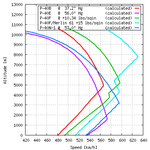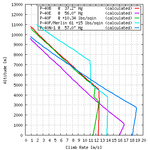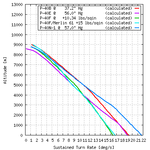- Thread starter
- #41
Clay_Allison
Staff Sergeant
- 1,154
- Dec 24, 2008
I was thinking of three speed so that you could have Low, Medium and High alt settings. Mostly I was thinking it was a way to get around our lack of a two-stage supercharger. Adding an extra speed is just another little gear on the gearbox. The larger Impeller is a must though.Demetrious,
That figure is wrong.
I strongly suggest you read (or re-read) my response to you (post #140, 5th down from the top), from this thread - http://www.ww2aircraft.net/forum/aviation/p-40-warhawk-kittyhawk-17083-10.html - and note the link for those performance figures.
They're official USAF documents from 1949.
I can't see verification getting any more definitive than that.
...also, why stop at 1500HP?
The Rolls Griffon eventually made upwards of 2300-2500 HP.
--------------------------------------------------------------------------
Ivan Clay,
Yes, you guys get it.
Modifications would have to be so drastic that you're going to end up with a new plane.
A P-46? Maybe.
Ivan's suggestions seem to almost suggest a "Curtiss P-51".
...also, I see no mention of modifying the prop.
I would think it would at least be some waste of all that added power, if it were to simply turn the same prop that was used before the modification.
Wider, longer or more blades, but something should definately change with that aspect, as well.
This would give you the most satisfactory results from the installation of the upgraded powerplant.
Also, Clay, the reason I made the connection to the 109 is that both the Griffon and the DB-605 are of similar displacement and configuration (V-12 of approximately 2230 cu.in.).
Add to that, that the 109 is basically a modified 108 with a great big engine hanging off the front, and you can see that your idea of the Griffon powered P-40 is very similar.
However, remember that the Allison, being a lighter weight engine, isn't as stout (or doesn't appear to be, anyway) as the Rolls engines, thus the problems with added stress when dealing with power enhancing "add-ons".
Triple-speed supercharging might be an almost "Rube Goldberg" approach to the idea.
I still think a two-speed, single stage, intercooled supercharger with a larger impeller is the way to go with the Allison.
As Jabberwocky stated earlier, its not so much about total HP, its how much you can retain upstairs.
So, if the Allison made, lets say, 1350-1400HP at take off, but could still be making 1100-1150 HP at 20-30K feet, both the early 51's and the P-40's would've been better performers, overall.
The two-speed single stage, intercooled Allison with the prop used on the 51-D, would've given the P-40 an infinately better climb rate ("lack of bounce" being a detraction I've heard before about that plane) and better performance at the higher altitudes that the 109 liked to fight at.
Elvis



